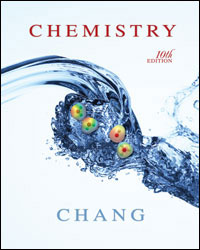1 A) become basic B) decrease in temperature C) condense D) increase in temperature E) decrease in pressure 2 2 is burned according to the chemical equation shown below?
2 SO2 (g) + O2 (g) ----> 2 SO3 (g) ΔHo rxn = -198 kJA) 5.04 x 10-2 kJ B) 9.9 x 102 kJ C) 207 kJ D) 5.0 x 102 kJ E) None of the above 3 o C. Determine the energy, in calories, necessary to raise the temperature of a 55.5 g piece of aluminum from 23.0 to 48.6o C.A) 109 cal B) 273 cal C) 577 cal D) 347 cal E) 304 cal 4 o C and then dropped into a beaker containing 87.0 g of water at a temperature of 24.10o C. The temperature of the water rose to a final temperature of 27.63o C. The specific heat of water is 4.184 J/g·o C. What is the specific heat of the alloy?A) 0.313 J/g·o C B) 2.16 J/g·o C C) 0.118 J/g·o C D) 1.72 J/g·o C E) None of the above 5 3 OH) was burned in a constant-volume bomb calorimeter, the water temperature rose from 20.27o C to 26.87o C. If the mass of water surrounding the calorimeter was exactly 1000 g and the heat capacity of the bomb calorimeter was 1.75 kJ/o C, calculate the molar heat of combustion of CH3 OH. The specific heat of water is 4.184 J/g·o C.A) -8.17 x 105 kJ/mol B) -817 kJ/mol C) 1.88 kJ/mol D) 817 kJ/mol E) None of the above 6 o C, does the symbol ΔHo f [H2 SO4 (l)] refer?A) H2 (g) + S(s) + 2 O2 (g) ----> H2 SO4 (l) B) H2 SO4 (l) ----> H2 (g) + S(s) + 2 O2 (g) C) H2 (g) + S(g) + 2 O2 (g) ----> H2 SO4 (l) D) H2 SO4 (l) ----> 2 H(g) + S(s) + 4 O(g) E) 2 H(g) + S(g) + 4 O(g) ----> H2 SO4 (l) 7 2 (g) + ½O2 (g) ----> SO3 (g) ΔHo rxn = -99 kJ, what is the enthalpy change for the following reaction?
2 SO3 (g) ----> O2 (g) + 2 SO2 (g)A) 99 kJ B) -99 kJ C) 49.5 kJ D) -198 kJ E) 198 kJ 8 2 H4 (g), given the following data:
C2 H4 (g) + 3 O2 (g) ----> 2 CO2 (g) + 2 H2 O(l) ΔHo f = -1411 kJ;
C(s) + O2 (g) ----> CO2 (g) ΔHo f = -393.5 kJ;
H2 (g) + ½O2 (g) ----> H2 O(l) ΔHo f = -285.8 kJA) 731 kJ B) 2.77 x 103 kJ C) 1.41 x 103 kJ D) 87 kJ E) 52 kJ 9 o rxn for the combustion reaction of CH4 shown below given the following:
ΔHo f CH4 (g) = -74.8 kJ/mol;
ΔHo f CO2 (g) = -393.5 kJ/mol;
ΔHo f H2 O(l) = -285.5 kJ/mol.
CH4 (g) + 2 O2 (g) ----> CO2 (g) + 2 H2 O(l)A) -604.2 kJ B) 889.7 kJ C) -997.7 kJ D) -889.7 kJ E) None of the above 10 7 H6 O2 ) was burned in a bomb calorimeter. The heat capacity of the entire apparatus, including the bomb, pail, thermometer, and water, was found to be 11,145 J/K. As a result of the reaction, the temperature of the calorimeter and water increased 4.627 K. What is the molar heat of combustion of benzoic acid?A) 4.84 x 106 kJ/mol B) -2.96 kJ/mol C) -4844 kJ/mol D) 549.1 kJ/mol E) 51.57 kJ/mol 11 A) Radiant energy; solar energy able to influence global climate patterns B) Thermal energy; related to temperature irrespective of the volume C) Energy; capacity to do work D) Chemical energy; potential energy 12 A) converted to one form to another B) can be created and destroyed C) used within a system without consequences D) none of the above 13 A) True B) False 14 q +w , which sign is correctly associated?A) q ; - exothermicB) q ; + endothermicC) w ; + by system on surroundingD) w ; + on system by surroundings





